Aylesbury, Buckinghamshire, England, UK 作者: 来源: 发布时间:2021-06-09
I. Population and Area
Continent: Europe
Country: The U.K
State/Province: England
City/Town: Norwich, Norfolk
Total Area: 350 (sq mi)
Population in 2011: 181.0(thousand)
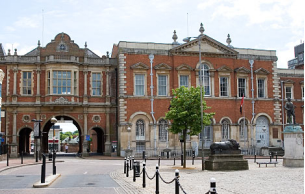
II. Natural Geography (environment and resources)
Future developments
If plans are approved to increase expected new housing capacity add as expected twenty thousand people, suburban Aylesbury could become largely or wholly contiguous with the neighbouring villages of Bierton, Hartwell, Stoke Mandeville, Stone, Sedrup and Weston Turville. Distinct whole areas that have a notably high property price in the town are Bedgrove, the conservation area around St. Mary's Church and Queens Park, particularly facing onto the canal.Anticipated developments are expected to raise the urban population of Aylesbury from its current approximation of 75,000 to 100,000 between 2018 and 2023. London is centred 36.5 miles (58.7 km) southeast, over the Chilterns.
Elevations, soil and geology
Aylesbury is immediately southeast of the upper River Thame that flows past Thame to Dorchester on Thames and is partly sited on the two northernmost outcrops of Portland (lime)stone in England bisected by a small stream, Bear Brook which gives a relatively prominent position in relation to the terrain of all near, lower, fields and suburbs, which have largely slowly permeable Oxford Clay and Kimmeridge Clay soils. Elevations range from 72.5m above mean sea level to 95m AOD in contiguous parts of the town, however nearest villages range from 85m-90m to the north or from 85m to 115m on a narrow ridge to the southwest at Stone and towards the Chilterns to the southeast (Weston Turville, Stoke Mandeville and North Lee)
Rail
The town is served by Aylesbury railway station and Aylesbury Vale Parkway railway station; the latter is terminus of passenger services of the London to Aylesbury Line from London Marylebone. Stoke Mandeville also lies in the town's urban area. Railways came to Aylesbury early, in 1839 when the Aylesbury Railway opened from Cheddington on Robert Stephenson's London and Birmingham Railway. The Wycombe Railway (later Great Western Railway) arrived via Princes Risborough on 1 October 1863, and on 23 September 1868 the Aylesbury and Buckingham Railway (later Metropolitan Railway) was opened from Verney Junction to almost connect a loop with the Wycombe Railway.
Roads
Aylesbury is served by the A41 from London to Birkenhead, which becomes the M40 however at Bicester 13 miles (21 km) west (by north) of Aylesbury. The A413 and A418 roads also run through the town. The M40 motorway at junction 9 is 14.7 miles (23.7 km) away and the M25 motorway is just over 21 miles (34 km)'s drive.
Buses
In 2006, work commenced on the public transport hub, a scheme comprising a one-way loop of bus lanes around the town's inner ring road, which includes improvements to the connectivity between bus and rail services. The first two phases of this scheme were completed in 2007, providing new bus lanes on Exchange Street, New Street, Friarage Road and White Hill, and also opened up High Street to buses. The final two phases, including the Bourg Walk Bridge and Station Boulevard were officially opened in April 2009.
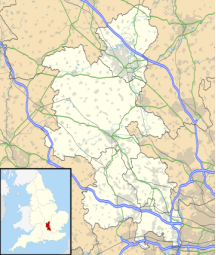
III. Economy
Average Salary in Aylesbury, England: Buckinghamshire £26k


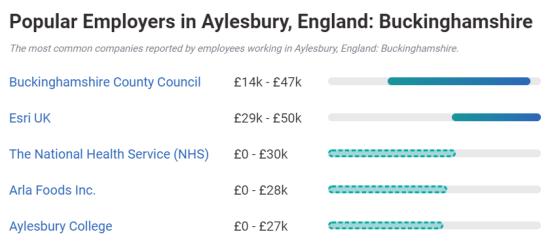
About Aylesbury, England: Buckinghamshire
The average salary in Aylesbury, England: Buckinghamshire is £26k. Trends in wages decreased by -100.0 percent in Q2 2020. The cost of living in Aylesbury, England: Buckinghamshire is 100 percent higher than the national average. The most popular occupations in Aylesbury, England: Buckinghamshire are Teaching Assistant (TA), Project Manager, (Unspecified Type / General), and Customer Service Representative (CSR) which pay between £17k and £46k per year. The most popular employers in Aylesbury, England: Buckinghamshire are Buckinghamshire County Council, Esri UK, and The National Health Service (NHS).
Reference Website:
https://www.payscale.com/research/UK/Location=Aylesbury-England%3A-Buckinghamshire/Salary
IV. Industrial Characterisitics
Major industries:
15th century
By 1477 flour was being ground in the town for surrounding parishes. By the modern period this had grown into a huge established industry: the last mill in Aylesbury was closed in the 1990s (Hills & Partridge on the canal behind Tesco). By 1560 the manufacture of needles had become a large industry in Long Crendon a village close by which was an important production centre.
17th century – lace making
In 1672 poor children in Buckinghamshire were taught to make lace as a way to make a living. Bucks lace as it became known quickly became very sought after and production boomed as the lace was mainly made by poor women and children. The lace-making industry had died out by Victorian times, however, as new machine-made lace became preferable.
19th century – canals
In 1814, the Aylesbury arm of the Grand Union Canal from Marsworth was opened bringing major industry to the town for the first time. At the same time the Wendover arm was built leading to nearby Wendover.
20th century – motor manufacture
From 1919 until 1925 the Cubit Engineering Works on Bicester Road was a volume manufacturer of motor vehicles. Approximately 3,000 cars were built, but a somewhat slow and heavy design could not survive the onslaught from cheap American competition. The works have been demolished for a domestic housing development. The marque is commemorated by Cubitt Street (and Edge Street) which traverses the old works.
Major projects and related introductions:
Project: HS2
Over the next 12 years North Bucks is set to undergo changes that will completely change the landscape of the region, but a huge question mark remains over whether the people affected have had their voices heard or represented.
Construction work for phase one of HS2, running from London to the West Midlands is just getting underway and will continue until 2026, tearing through the heart of the Aylesbury Vale countryside from Waddesdon to Brackley in the process.
The whole project is now estimated to cost £55.7 billion, almost double the original estimate, and one point of contact with the environmental harm posed are the 108 ancient woods threatened with loss or damage, according to the Woodland Trust.
V. Attractions
1. Buckinghamshire County Museum:
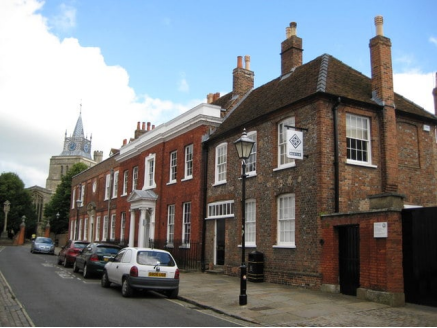
This museum explores many strands of Buckinghamshire’s human and natural history, and is housed in a row of beautiful flat-fronted buildings on Church Street. The oldest portion of the complex is a timber-framed guildhall from the 16th-century, with rare murals intact.
2. Market Square:
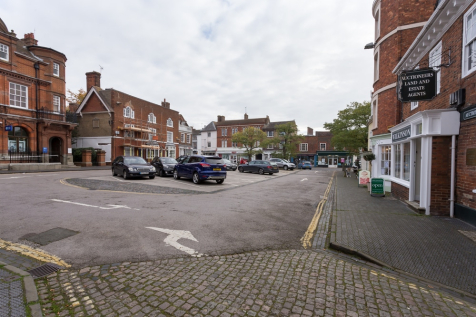
This long, rectangular square in the heart of Aylesbury has fine buildings and interesting pockets of history all around. On the southeast end, beside the striking Corn Exchange is the Aylesbury Crown Court, which shut its doors for the last time in 2018. This Palladian building was completed in 1740, and in 1963 was where the culprits of the Great Train Robbery were sentenced.
3. Norwich Castle Museum and Art Gallery:
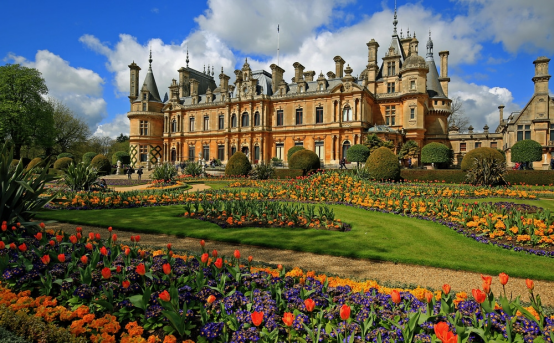
A miniature Château de Chambord in the Aylesbury Vale, Waddesdon Manor is a neo-Renaissance mansion built for Baron Ferdinand de Rothschild between 1874 and 1889. In 1957 the estate was bequeathed to the National Trust by his great-nephew James de Rothschild and was named Large Visitor Attraction of the Year by “Visit England” in 2017. Baron Ferdinand used the house to show off his invaluable collections of 18th-century French furniture, Beauvais and Gobelins tapestries, Sèvres ceramics, exquisite panelling, Savonnerie carpets and paintings by Reynolds, Gainsborough and 17th-century Dutch masters.
Reference Website:
https://www.thecrazytourist.com/15-best-things-to-do-in-aylesbury-buckinghamshire-england/
VI. History
The town name is of Old English origin. Its first recorded name Æglesburgh is thought to mean "Fort of Ægel", though who Ægel was is not recorded. It is also possible that Ægeles-burh, the settlement's Saxon name, means "church-burgh", from the Welsh word eglwys meaning "a church"
Excavations in the town centre in 1985 found an Iron Age hill fort dating from the early 4th century BC. Aylesbury was one of the strongholds of the ancient Britons, from whom it was taken in the year 571 by Cutwulph, brother of Ceawlin, King of the West Saxons; and had a fortress or castl"of some importance, from which circumstance probably it derives its Saxon appellation"
Aylesbury was a major market town in Anglo-Saxon times, the burial place of Saint Osgyth, whose shrine attracted pilgrims. The Early English parish church of St. Mary (which has many later additions) has a crypt beneath. Once thought to be Anglo-Saxon, it is now recognised as being of the same period as the medieval chapel above.[citation needed] At the Norman conquest, the king took the manor of Aylesbury for himself, and it is listed as a royal manor in the Domesday Book, 1086. Some lands here were granted by William the Conqueror to citizens upon the tenure that the owners should provide straw for the monarch's bed, sweet herbs for his chamber and two green geese and three eels for his table, whenever he should visit Aylesbury.
A notable institution is Aylesbury Grammar School which was founded in 1598. The original building is now part of the County Museum buildings in Church Street and has grade II* architecture;other grammar schools now include Sir Henry Floyd Grammar School and Aylesbury High School. Other notable buildings are the King's Head Inn, (which with the Fleece Inn at Bretforton, is one of the few public houses in the country owned by the National Trust still run as a public house) and the Queens Park Centre.
James Henry Govier the British painter and etcher lived at Aylesbury and produced a number of works relating to the town including the church, canal, Walton, Aylesbury Gaol, the King's Head Inn and views of the town during the 1940s and 1950s, examples of which can be seen in the Buckinghamshire County Museum in Aylesbury.
VII. Culture
A live music nightclub in Aylesbury was prominent in the 1960s, 1970s and 1980s – renamed the Friars' Club in 1969 – which hosted many of the top artists of the time including Jimi Hendrix, the Rolling Stones, Cream, Otis Redding, the Clash, Hawkwind, Queen, Genesis, U2, David Bowie, Talking Heads, Marillion & the Ramones. Friars' Club celebrated its 40th anniversary in 2009, by holding three special concerts that reflected the various phases of the club's musical history. The first concert in June featured the Edgar Broughton Band, the Groundhogs and the Pretty Things.
The rock band Marillion have a close association with Aylesbury. They originally formed there, with the band's first single, 1982's "Market Square Heroes", taking its title inspiration from Aylesbury's Market Square. The band continue to be based in the area, with their Racket Records studio still close to Aylesbury, and in 2007 the band performed together with their original lead singer, Fish, for the first time in 19 years at Aylesbury.
Aylesbury Methodist Church holds an annual organ recital, which attracts prominent national organists. The Roald Dahl Children's Gallery in Church Street, Aylesbury, is a children's museum in honour of novelist Roald Dahl that opened on 23 November 1996. Aylesbury hosts the Roald Dahl Festival, a procession of giant puppets based on his characters, on 2 July.
Comedian and actor Ronnie Barker (1929–2005) began his acting career in the town in the late 1940s and in September 2010, almost five years after his death, a bronze statue of him was unveiled by actor David Jason and Barker's one time co-star Ronnie Corbett (the other half of the Two Ronnies) on a new public place in Exchange Street.
VIII. Other information
The town centre has many pubs and bars (for some years plagued with anti-social behaviour), and the Queens Park Centre, the UK's largest independent arts centre.
The local newspaper is the Bucks Herald, which started publishing in January 1832. The local radio station is Mix 96, which first broadcast in April 1994. One of the more prominent buildings in Aylesbury is the "Blue Leanie" office block, home to Lloyds Bank. When first built it was thought to be a potential hazard to passing motorists, due to the sun reflecting off its large mirrored surface. As a result, a line of mature trees was planted alongside the main road to prevent dazzling.
Aylesbury Waterside Theatre, a new £42 million theatre, with 1,200 seat auditorium, opened in October 2010. In addition to this, the surrounding area is being redeveloped as part of the £100 million Waterside project.When this is completed, originally planned for June 2010, there will be 260,000 sq ft (24,000 m2) of new retail floor space and 1,100 new jobs created, although when this will be completed now is unclear. A Waitrose supermarket opened opposite the theatre in August 2013, along with a Travelodge Hotel. Branches of Wagamama and Nando's restaurants opened on 'The Exchange' in February 2014, next to the Odeon cinema on Exchange Street. A branch of Zizzi is also expected to open in early 2015, as part of a council plan to revitalise the 'Waterside' area. The Zizzi opening turned out to be a rumour and in fact a Gourmet Burger Kitchen (GBK) opened instead.
The Bourg Walk Bridge (also called the Southcourt Bridge or the Roberts Bridge after a local councillor) opened in March 2009 connecting Southcourt to Aylesbury town centre. The focus of the footbridge is a central concrete pillar with four suspension cables supporting the structure. This bridge forms a central part of the Aylesbury Hub project. Bourg Walk was nominated and won the Engineering Excellence Award 2009 awarded by the Institution of Civil Engineers – South East England branch .
IX. Contact information
Mayor/Officer: Cllr Mike Smith
Tel: 0300 131 6000
Mail: registrars@buckinghamshire.gov.uk
